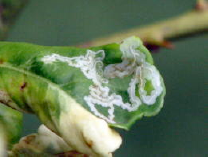 Spring is in the air! We have much to look forward to -- wildflowers along the roadsides, flowers in our gardens, and fruit in our orchards. Spring and early summer are important for our home orchards. Good practices now will benefit the trees all year.
Spring is in the air! We have much to look forward to -- wildflowers along the roadsides, flowers in our gardens, and fruit in our orchards. Spring and early summer are important for our home orchards. Good practices now will benefit the trees all year.
Citrus is really on our minds right now. When the danger of frost damage has passed, it is safe to prune them back to live wood. If you are not sure where to make your pruning cuts, wait until they leaf out.
Fertilize citrus every 4-6 weeks through August with a balanced organic fertilizer such as Microlife. Specialty citrus fertilizers are available such as Nelson's Citrus-Avocado fertilizer if you prefer. Always apply fertilizers in accordance with the package directions. Too much fertilizer can do more harm than none at all.
Leaf miners will lay their eggs on citrus leaves when they are about the size of a mouse's ear. Leaf miner damage is mostly cosmetic, but if it bothers you it can be treated naturally by spraying spinosad or neem oil during the active growing season. Spray every two weeks, alternate the products, and be sure to follow all package directions for mixing, application and disposal of any unused mix.
If you see any signs of scale, treat with an insecticidal soap mixed at 1 teaspoon per gallon of water. You have to catch them in their crawling stage, so apply the spray at 7-10 days intervals for several treatments.
Traditional fruit trees such as peaches, plums, pears and apples should have had their major pruning done already. The next task will be to thin the fruit. Thinning should be done when the fruits are about the size of a small marble. Use the width of your hand across the knuckles as a guide. Remove all but one fruit in each cluster and thin until there is a hand's width between the fruits down each limb. Thinning reduces the number of fruits, but increases the size and quality of individual fruits. Thinning is difficult for gardeners that are new to fruit culture, but the results will convince you that it is beneficial.
All citrus and fruits should be mulched with a good quality organic mulch. Mulch moderates soil temperature and preserves moisture as well as reducing competition from turf and weeds. Buy native mulch, but read the package carefully and buy from a smaller, knowledgeable nursery such as Buchanan’s in the Heights or Wabash Feedstore on Washington Avenue. There are not laws regulating what manufactures can grind up and call mulch (ie fences and palettes). Additionally, Nature’s Way Resources in Conroe makes quality mulch, compost and garden soil.
You can add 1-2 inches of compost before you mulch, then top the compost with the mulch. Mulch all the way past the drip line of the trees, but do not apply more than 3-4 inches total thickness of compost and mulch.
As the temperatures begin to warm up we will need to increase watering. Fruit trees do not like to be drought stressed, especially when maturing a load of fruit. They will drop their fruit to protect themselves and will generally not perform well. A deep soaking once a week is more beneficial than frequent shallow watering. During the hottest part of the summer you may need to soak them more than once. If you are in doubt, use an inexpensive moisture meter available at your local nursery or garden center.
Fertilizing fruits depends on the family or group. A complete calendar for fertilizing and maintaining fruits and citrus can be printed for free from the virtual fruit gardening classroom found atwww.thegardenacademy.com. Some fruits should never be fertilized, such as figs. Figs do well with compost and mulch only. They do not compete well with turf and should be mulched over their entire drip line.
After the harvest, you will need to be diligent about cleaning up any fallen fruit at the base of the tree. This fruit can harbor pests and removing it will help break or reduce the cycle. You can move the fruit to a bird feeder elsewhere in the garden. Many species of butterflies and beneficial insects will enjoy feeding on the rotting fruits.
Home orchard culture can become a very gratifying hobby. Putting in a little time each spring will result in better production this summer and healthier trees for years to come.
This column is produced by Urban Harvest. Learn about gardening classes, community gardens and orchards, farmers markets and more at Urban Harvest website. The article is written by Angela Chandler and Heidi Sheesley. Angela is a life-long hobby gardener. She teaches a variety of garden subjects and blogs regularly on her site thegardenacademy.com. Heidi is the owner of TreeSearch Farms Inc., a wholesale grower of perennials, natives and unique plants.